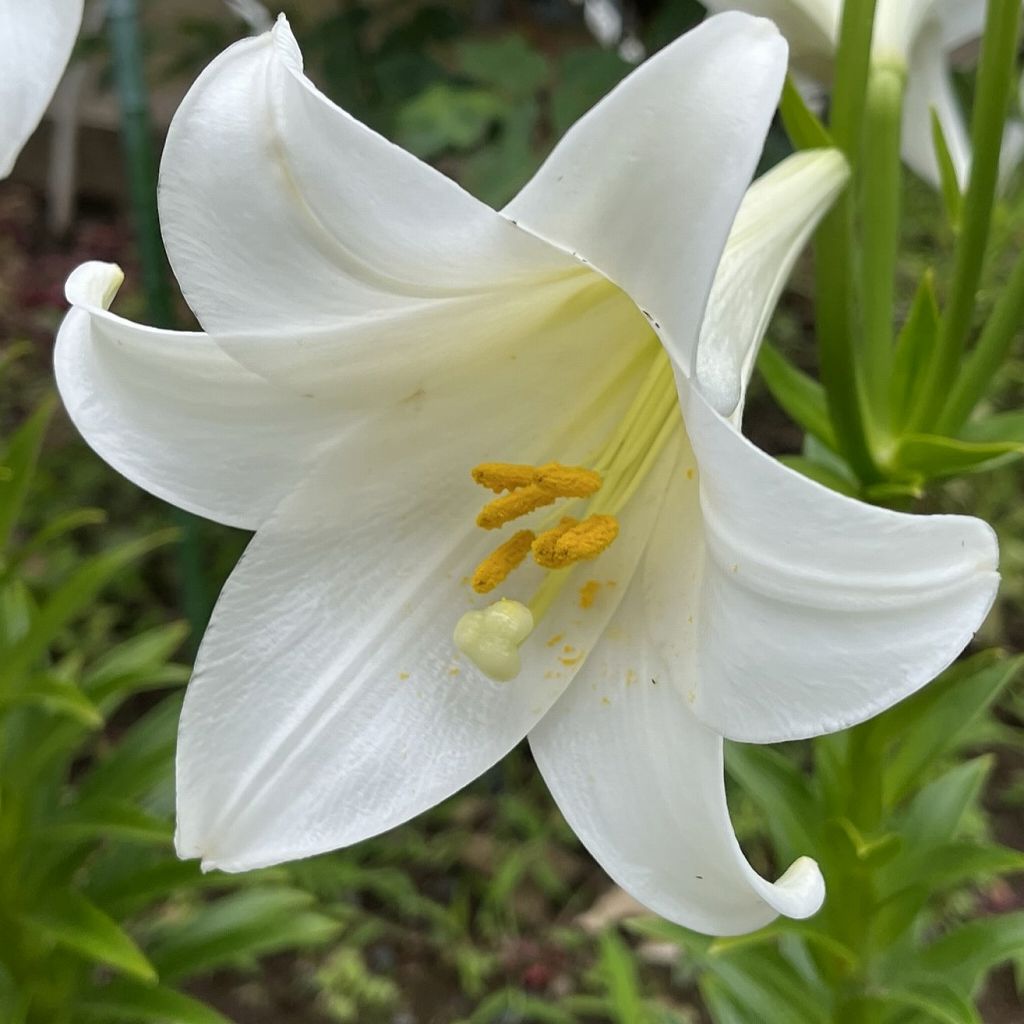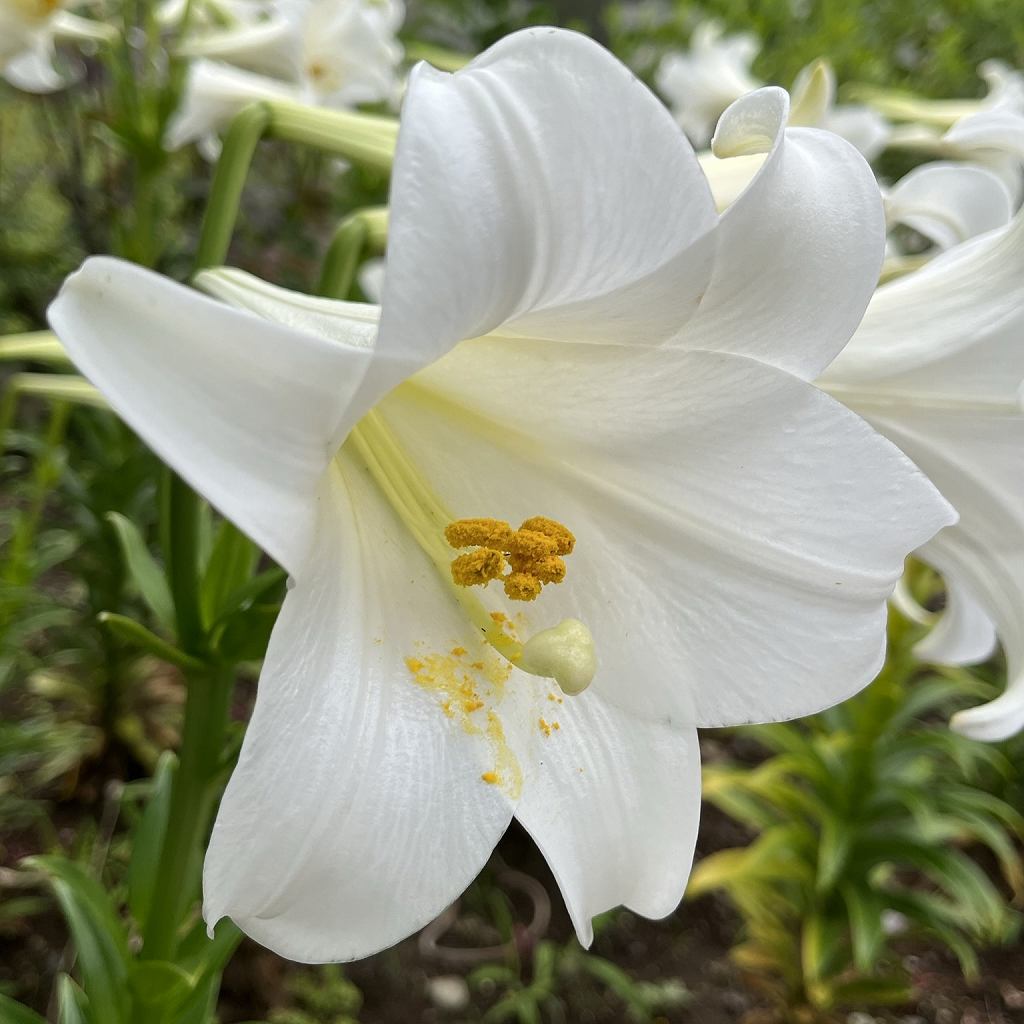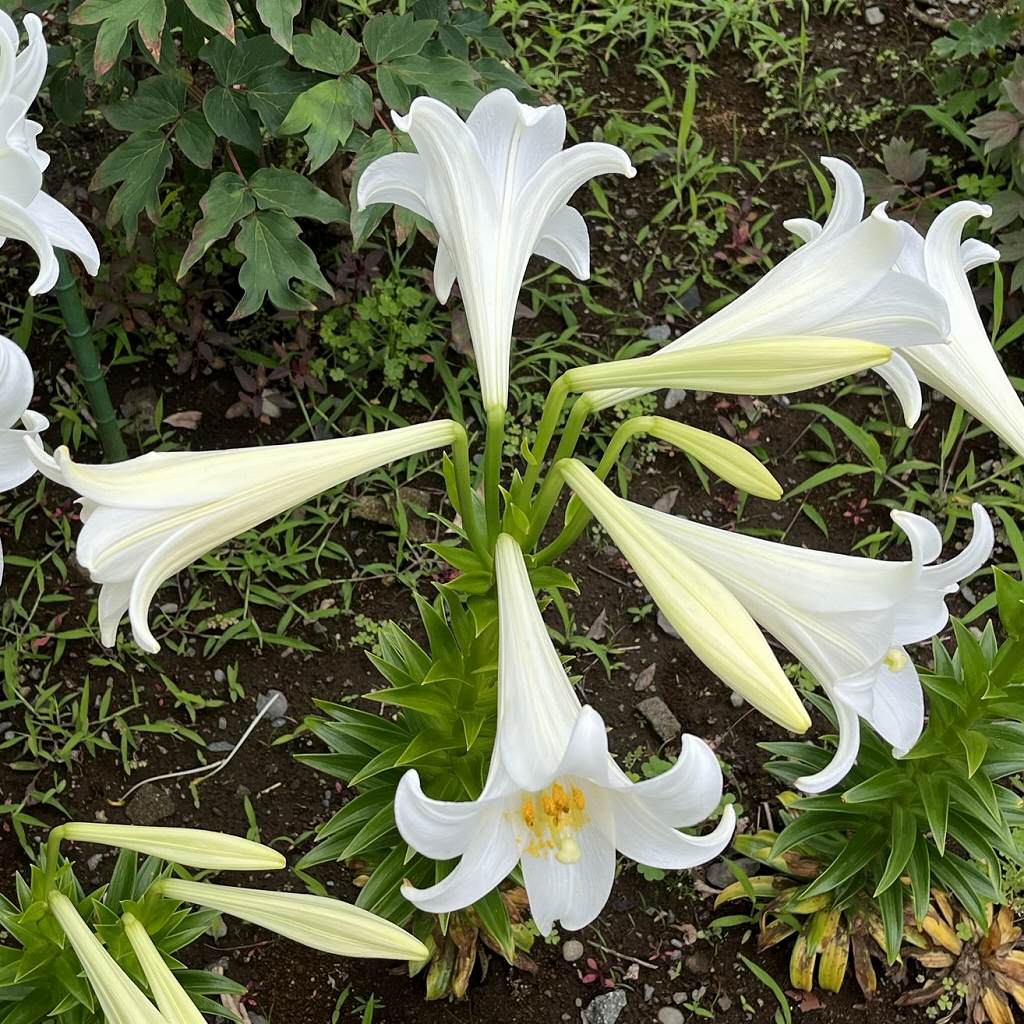テッポウユリは茎先で横向きに咲いて筒状の漏斗形。花被片が外側3枚、内側3枚で反り返り、芳香があります。花言葉は純潔、甘美、威厳。
Easter Lily flowers bloom sideways at the tip of the stem, and their shape is tubular and funnel-shaped. The flower has 3 outer perianths and 3 inner perianths and is fragrant. The language of flower is purity, sweetness and majesty.
【仮名】テッポウユリ
【和名】鉄砲百合
【英名】Easter Lily, Trumpet Lily
【学名】Lilium longiflorum
【誕生】07/ 13
【開花】06, 07, 08月
【花色】White




テッポウユリ
テッポウユリの概要
テッポウユリはユリ科の多年草。原産地は日本の南西諸島で、日当たり、風通し、水はけのよい海岸近くの崖などで自生しています。栽培は観賞用に庭植え、鉢植えのほか、切り花を冠婚葬祭などに。鱗茎は打撲傷の塗り薬などにも用いられます。花言葉は「純潔」「甘美」「威厳」。
テッポウユリの名前
テッポウユリの名前の由来は花が筒状で、昔の「鉄砲」に似ているから。ユリは大きな花が風で揺れる「揺すり」からの転訛です。漢字の「百合」は多くの鱗片が重なり合った鱗茎だから。ラテン語の属名リリウムは「白色」、種小名ロンギフロルムは「長い形の花」という意味です。
テッポウユリの姿形
テッポウユリの鱗茎は白色の鱗片が重なって丸い形。茎は剛直、葉は幅広の披針形で互生します。花は茎先で横向きに咲いて筒状の漏斗形。花被片が外側3枚、内側3枚で反り返り、芳香があります。雄しべは6本、雌しべは柱頭が3裂。花後の蒴果は熟すと裂けて種子を散らします。
テッポウユリの近縁
テッポウユリの近縁種「高砂百合」は台湾が原産地。花が少し大きく、薄い紫色の筋が入り、やや下向きに咲きます。葉が細いので別名「細葉鉄炮百合」。鉄砲百合との交雑種「新鉄炮百合」は花が真っ白なのに葉が細く、さらに交雑が繰り返されると外見から判別できなくなります。
テッポウユリの伝搬
テッポウユリは19世紀に原産地の日本から欧米へと伝搬。教会の祭壇では「庭白百合」の代わりに鉄砲百合が飾られるようになります。その結果、米国の西海岸が鉄砲百合の一大産地に。キリスト教ではイエスの十字架刑でゲッセマネの園に白色の花々が咲いたという伝承があります。
Easter Lily
Easter Lily is a perennial plant of the Liliaceae family. The place of origin is the Nansei Islands of Japan, where it grows naturally on cliffs near the coast where there is sunlight, ventilation, and good drainage. In addition to being cultivated in gardens and pots for ornamental purposes, cut flowers are used for ceremonial occasions. The bulbs are also used as ointments for bruises. The language of flower is “purity”, “sweetness”, and “majesty”.
Easter Lily’s Japanese name means “gun lily”. This is because the flower is tubular and resembles an old “gun”. The Japanese name of lily comes from the fact that the large flowers sway in the wind. The kanji for lily means a bulb with many overlapping scales. The Latin genus name Lilium means “white” and the species longiflorum means “long-shaped flower”.
The bulb of Easter Lily is rounded with overlapping white scales. The stem is rigid, and the leaves are broad lanceolate and alternate. The flower blooms sideways at the tip of the stem and is funnel-shaped. The perianth has 3 outer and 3 inner tepals, and is fragrant. There are 6 stamens, and the pistil has a 3-lobed stigma. The post-flowering capsule splits when ripe and scatters the seeds.
Easter Lily’s relative “Lilium formosanum” is native to Taiwan. The flowers are slightly larger, have pale purple streaks, and bloom slightly downward. There is another name “Narrow-leaved Easter Lily” because the leaves are thin. Hybrids of longiflorum and formosanum have pure white flowers but thin leaves, and if the crossing is repeated, it becomes impossible to distinguish from the appearance.
Easter Lily propagated from its native Japan to Europe and the United States in the 19th century. Church altars then displayed Easter Lily instead of “Madonna Lily”. As a result, the West Coast of the United States became a major production area for Easter Lily. In Christianity, there is a legend that white flowers bloomed in the Garden of Gethsemane after Jesus was crucified.


